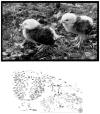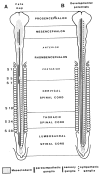Development and evolution of the neural crest: an overview
- PMID: 22230617
- PMCID: PMC3351559
- DOI: 10.1016/j.ydbio.2011.12.042
Development and evolution of the neural crest: an overview
Abstract
The neural crest is a multipotent and migratory cell type that forms transiently in the developing vertebrate embryo. These cells emerge from the central nervous system, migrate extensively and give rise to diverse cell lineages including melanocytes, craniofacial cartilage and bone, peripheral and enteric neurons and glia, and smooth muscle. A vertebrate innovation, the gene regulatory network underlying neural crest formation appears to be highly conserved, even to the base of vertebrates. Here, we present an overview of important concepts in the neural crest field dating from its discovery 150 years ago to open questions that will motivate future research.
Copyright © 2012. Published by Elsevier Inc.
Figures



References
-
- Ayer-Le Lievre CS, LeDouarin NM. The early development of cranial sensory ganglia and the potentialities of their component cells studied in quail-chick chimeras. Dev Biol. 1982;94:291–310. - PubMed
-
- Baker CVH, Bronner-Fraser M, LeDouarin NM, Teillet MA. Early- and late-migrating cranial neural crest populations have equivalent developmental potential in vivo. Development. 1997;124:3077–3087. - PubMed
-
- Baker CVH, Bronner-Fraser M. The origins of the neural crest. Part I: Embryonic induction. Mechanisms of Development. 1997;69:3–11. - PubMed
-
- Baker C, Bronner-Fraser M. Vertebrate cranial placodes: I. Embryonic induction Dev Biol. 2001;232:1–61. - PubMed
Publication types
MeSH terms
Grants and funding
LinkOut - more resources
Full Text Sources

